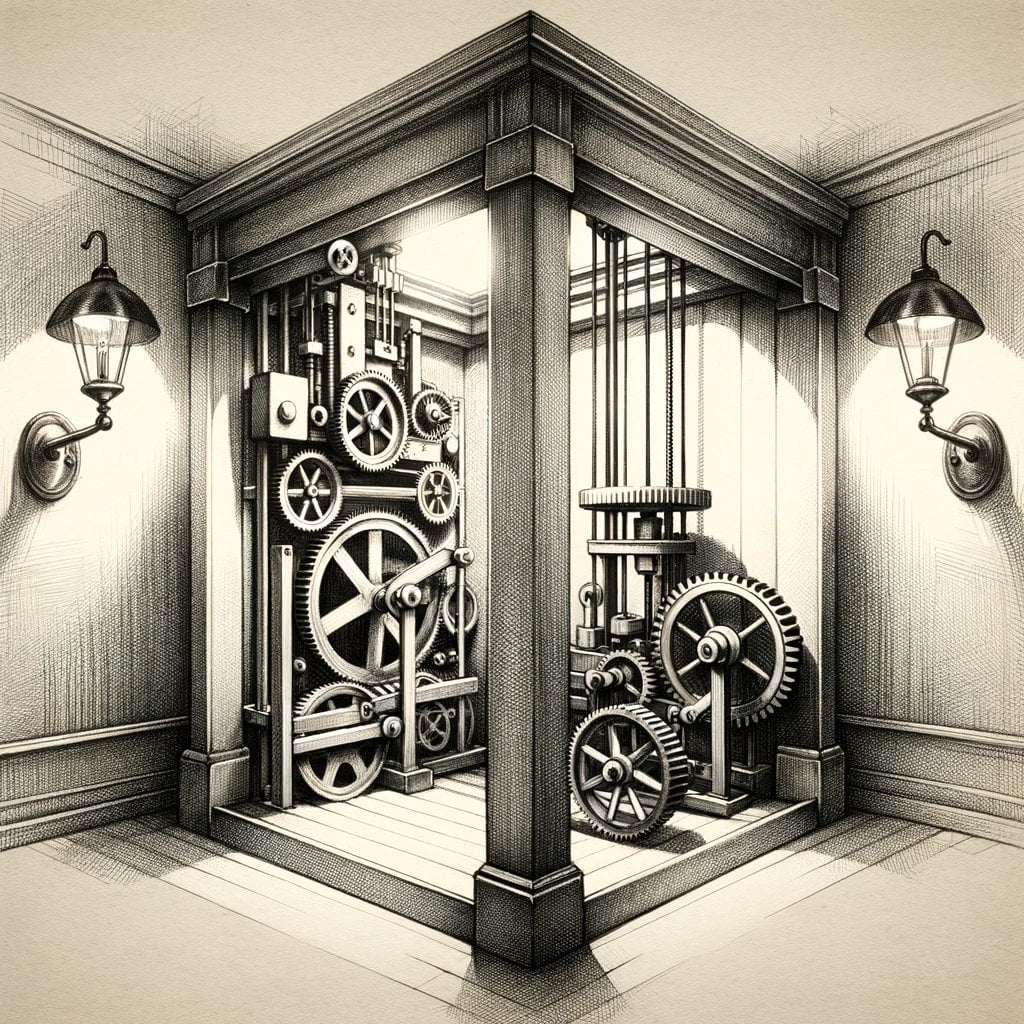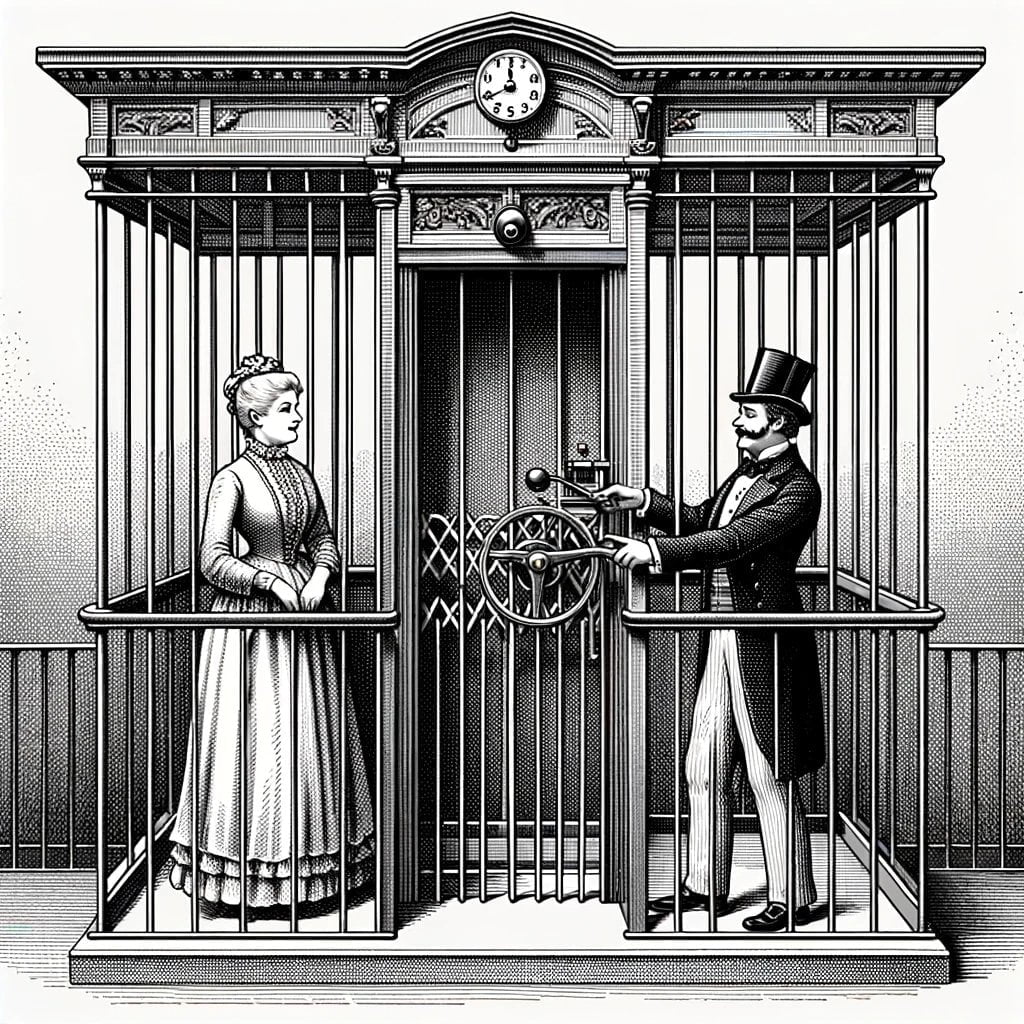Hop into that elevator and let’s take a trip back in time. Who thought of this awesome way to zoom up and down buildings? You’ll be surprised by the inventor behind this everyday wonder. Get ready for a story of smarts, hard work, and the quest to conquer the vertical world.
Who Invented the Elevator?
Imagine a world without elevators. How would you reach the 100th floor of a skyscraper? Or move heavy furniture up to your apartment?
Well, people have been thinking about this for centuries. And guess what? They’ve come up with some pretty cool solutions!
Archimedes: The OG Elevator Guy
Back in the days of Ancient Greece, around 300 B.C., a smart guy named Archimedes invented a simple lifting machine. It used ropes and a hand-cranked drum to lift things. It wasn’t exactly a modern elevator, but it was a start.
Elisha Otis: The Safety Champ
Fast forward to 1852, and Elisha Otis had a brilliant idea. He invented the safety elevator, making it safe for people to ride in. His elevator had a special brake that locked the elevator in place if the cable broke. This invention opened the door to building skyscrapers.
Electric Elevators: Power Up!
In the late 1800s, electricity came into play. Werner von Siemens and Alexander Miles helped develop electric elevators, making them faster, more efficient, and more reliable.
Elevator Evolution: Leveling Up
Over the next 100 years, elevators kept getting better and better. They got automatic doors, microprocessors for smoother rides, and destination dispatch systems to get you to your floor faster.
Today, elevators are everywhere. They’re not just for tall buildings anymore. They’re in hotels, hospitals, shopping malls, and even our homes. They’ve changed the way we live and work, making our lives easier and more convenient.
Shoutout to the Elevator Pioneers
So, next time you step into an elevator, take a moment to appreciate the ingenuity of Archimedes, Elisha Otis, and the countless other inventors who made it possible. Without them, our world would be a lot less vertical!
When it comes to the history of inventions, one question that often comes to mind is, “When was the elevator invented?” The answer to this question may surprise you. The invention of the elevator can be traced back to ancient times, with evidence of mechanical lifts dating back to the Roman Empire. However, it wasn’t until the 19th century that the modern passenger elevator, as we know it today, was developed. If you’re curious to learn more about the fascinating history of elevators and when they were first invented, click here: When Was The Elevator Invented.
Archimedes and the Ancient Wonder: The Earliest Elevator
Prepare to be amazed as we delve into the fascinating history of elevators, and let’s start at the very beginning – the brilliant mind of Archimedes.
Imagine a time when building tall structures was a backbreaking endeavor. Archimedes, the genius behind so many scientific breakthroughs, had a solution: the ancient elevator. Around 236 B.C., he came up with a clever device using ropes, pulleys, and a handy winch that could make lifting heavy objects a breeze.
Centuries later, the Romans took Archimedes’ idea and ran with it. Beneath the grand Colosseum, they built an intricate elevator system powered by slaves who painstakingly transported gladiators and wild beasts to the arena below. It was a testament to their engineering skills and their flair for the dramatic.
As time marched on, water became the driving force behind elevators. Mills and factories used the relentless flow of water to power their mighty lifting machines. With these ingenious inventions, lifting heavy loads and materials became a walk in the park.
So, the next time you’re soaring up a towering skyscraper, take a moment to appreciate the ancient inventors who laid the foundation for our modern-day elevators. Archimedes, the Romans, and the water-powered pioneers – they all played a part in making this indispensable invention a reality.
Elisha Otis: The Safety Pioneer Who Transformed Elevators
Imagine stepping into an elevator a century and a half ago—a risky venture where a frayed rope could send you plummeting. That all changed thanks to Elisha Otis, the safety pioneer whose invention transformed elevators forever.
Otis, a tinkerer and inventor at heart, was not one for heights. So, when he was hired to install an elevator in a New York City factory in 1852, he had a brilliant idea: create a safety device to prevent the elevator from crashing if the rope snapped.
With ingenuity and determination, Otis crafted a simple yet effective safety brake. It was a metal device that engaged with a toothed track on the side of the elevator shaft, stopping the elevator’s descent in an instant.
Before Otis’s invention, elevators were unreliable and downright dangerous. People hesitated to use them, fearing for their lives. But after Otis’s safety brake, elevators became a safe and practical way to ascend high buildings.
Otis’s safety brake not only revolutionized elevator safety but also paved the way for the rise of skyscrapers. With reliable elevators, people could now work and live on higher floors, transforming the face of cities.
Otis’s legacy is evident in the countless elevators we use daily. His invention has made vertical transportation convenient, safe, and an integral part of modern life.
Key Takeaways:
- Elisha Otis’s safety brake made elevators reliable and safe, allowing for the construction of high-rise buildings.
- Before Otis’s invention, elevator rides were hazardous, with frequent accidents due to rope breakage.
- His safety brake gave people the confidence to use elevators, transforming urban landscapes and facilitating vertical mobility.
The Rise of Electric Elevators: A Major Technological Leap
Imagine a world without the convenience of elevators, skyscrapers towering above us, or the ease of effortlessly moving between floors. The invention and evolution of elevators have not only shaped our cities but also dramatically altered how we live and work.
In the early days, Elisha Otis, an American inventor, made a pivotal contribution to elevator technology. In 1852, he introduced a groundbreaking safety brake system that prevented elevators from crashing in the event of a snapped rope. This ingenious device became the foundation of elevator safety, paving the way for the construction of taller buildings and essentially changing urban landscapes forever.
But it was the late 1800s that witnessed a true technological revolution with the advent of electric elevators. Pioneers like Werner von Siemens and Alexander Miles replaced steam engines with electric motors, bringing a host of advantages. Electric elevators were faster, more efficient, and more reliable than their predecessors.
This transformation unlocked a world of architectural possibilities. No longer restricted by the limitations of steam power, architects and engineers could now design taller and more ambitious structures. The Empire State Building and the Chrysler Building, iconic landmarks in their own right, would not exist without the advancements made by electric elevators.
Key Takeaways:
- Elisha Otis’s safety brake: A game-changer in elevator safety, making high-rise buildings a possibility.
- Electric Elevators: Powered by electric motors, they brought speed, efficiency, and reliability to vertical transportation.
- Architectural Impact: These advancements fueled the construction of taller buildings, redefining urban skylines and the way we live and work.
From its humble beginnings to the sophisticated technology we rely on today, elevators have come a long way. Their continued evolution promises even more convenience, safety, and innovation in the years to come.
FAQ
Q1: Who invented the first elevator?
A1: Archimedes invented the first known elevator in 236 B.C.
Q2: What was the key innovation of Elisha Otis’s elevator?
A2: Elisha Otis invented the safety brake in 1852, which prevented the elevator from falling if the hoisting rope broke.
Q3: How did electric elevators revolutionize the construction of buildings?
A3: Electric elevators, developed towards the end of the 19th century, enabled the construction of taller buildings by providing a more efficient and reliable way to transport people and goods.
Q4: What were some of the early uses of elevators?
A4: Early elevators were used for lifting heavy objects, such as construction materials and goods, and for transporting people in palaces and other large buildings.
Q5: How have elevators evolved over time?
A5: Elevators have evolved significantly since their invention, with advancements in safety features, efficiency, and comfort. Modern elevators use advanced technologies such as microprocessors and sensors to ensure smooth and reliable operation.
- Unraveling Einstein’s Legacy: Who Inherited His Genius? - July 14, 2025
- Unlock Einstein’s Family Tree: Bernhard Caesar & Untold Stories - July 14, 2025
- Unveiling Bernhard Caesar Einstein: His Life & Albert Einstein’s Legacy - July 14, 2025



















